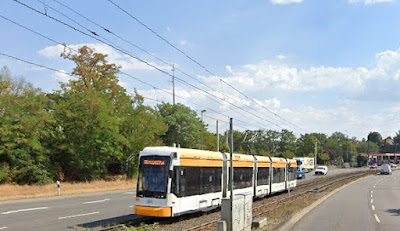Hymns Trams Ancient & Modern
fbb thinks it is fair to say that Mainz still runs a traditional European tram network. Sections of route in the town centre use street running alongside all traffic. Trams (and buses!) still terminate right outside the Hauptbahnhof ...
... and once beyond the very inner of inner city, reserved track, usually on a central aisle, is pretty much standard.
But at road junctions it is mix and match as it ever was! In his perusal, fbb did spot one location where trams have been extended to new development and routed over a main dual carriageway on a viaduct ...... but such lavishness of infrastructure is rare.
Likewise the design of the trams has followed a very traditional path. In the beginning it was four wheelers ...... sometimes coupled in pairs. Longer posher trams arrived post WW2 ...... the vehicle above being on a former steam tram route!
Soon articulation was the sensation ...... and we are beginning to move into the modern era, with or without a bend in the middle..
The more recent arrivals are slicker and longer.
But the infrastructure is still very simple. These are buses on rails running from typical bus stops!The system is certainly NOT "pre-metro".
Thankfully most stops are protected by railings to prevent the awaiting passengers from straying in front of a passing vehicle! Segregation is "only just"!!
So: let's take a virtual ride on the 52.
But first, please note that there is very little difference between tram and bus on the network map. This is a network, with one fare scale and one presentation. If it has wheels it is part of the one network!Trams have round blobs at their termini, buses have square boxes. So here is route 52 on the network diagram.After leaving Hauptbahnhof it branches left off the main road and is the exclusive public transport to its terminus. Here is the branch junction ...... and the dedicated amongst our loyal readership will recognise that this is where the two steam tram routes split.
As we trundle down the left hand fork, you can easily imagine a steam tram chugging slowly and mostly along its track!
We note that our route is along the central reservation of a broad boulevard, so where possible, trams were always separated from other traffic en route.
The stops are usually basic ...... and the surroundings on the 52 are not overdone with housing or customers. There is some new infill building ...... and more simple stops ...... until suddenly ...
... it becomes single track! The line then leaves the roadway ...... and plunges into a wooded copse!Lurking in there is the terminus. No loop, no turning circle, just a stub end of track, a stop sign and a shelter.
If this were not a city of approx 250,000 souls, you might think you were enjoying a ride on a preserved rural branch line.
Quaint!
If only it were still a steam tram ...???
Currently the 52 is a cross-town operation; but linked to another quaint branch.
Trams' 50 and 53 "main line" ...
Trams' 50 and 53 "main line" ...
... terminate in a typical European turning circle ...... with, presumably, separate stops (one in the background under the trees) for the two separate routes.But the two-stop 52 branch is very different. You would hardly know the tram was there.It, too, becomes single track at the end ...... and the terminus is also well hidden.But this time you have two sidings!
Luxury!Modern it ain't; again it's quaint.The 52 is not the most frequent of the tram timetables but PDFs are available.
It operates every 20 minutes Monday to Saturday (extract below) ...... and every 30 on Sundays. For all services in Mainz, the PDFs show every stop and every journey in full - which can make them hard to read.
And fares? Too complex for a simple blog from a simple blogger! Maybe a summary over the weekend - or maybe not.
In conclusion : fbb sees the tram network in Mainz as simple and delightfully old-style. The trams are modern but the infrastructure is "traditional", Some routes are quaint; most are perhaps more typical of an earlier era in tram operation. But whatever the characteristics of the system, it looks well used and efficient.
===========================
Tomorrow's Variety Blog
Don't get over-excited
BUT
fbb has found
an R60208!
============================
Next Variety blog : Sat 14 June


.jpg)

.jpg)

.jpg)




.jpg)
.jpg)
.jpg)







.jpg)









I suggest that it would be worthwhile for you to read the German Wikipedia version of the history of the Mainz Strassenbahn system at:-
ReplyDeletehttps://de.wikipedia.org/wiki/Stra%C3%9Fenbahn_Mainz
...and put the relevant sections of the text into a translator such as DeepL. In practice the lowest point of the system was around 1965, and since then there have been various extensions, and doubling of the track on some previously single track sections. These would seem to have been successful in encouraging more passengers to use the system. Recently 22 new, larger trams have been ordered from Skoda to replace the oldest existing trams with larger, fully low floor trams.
RC169